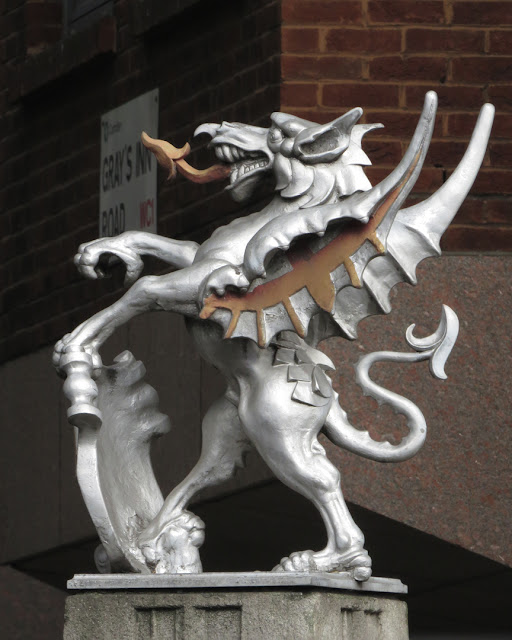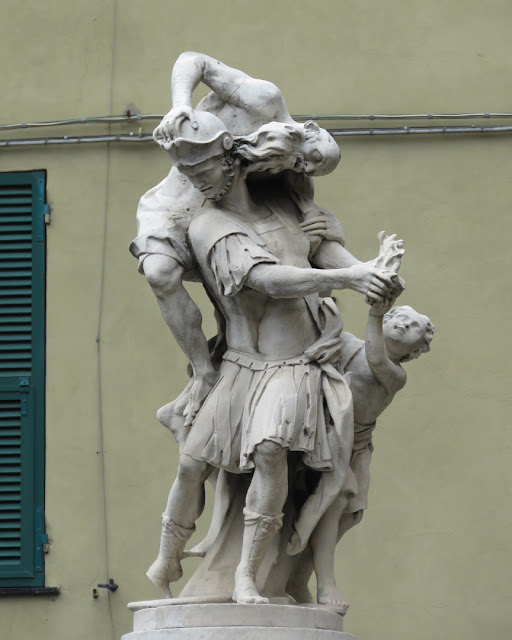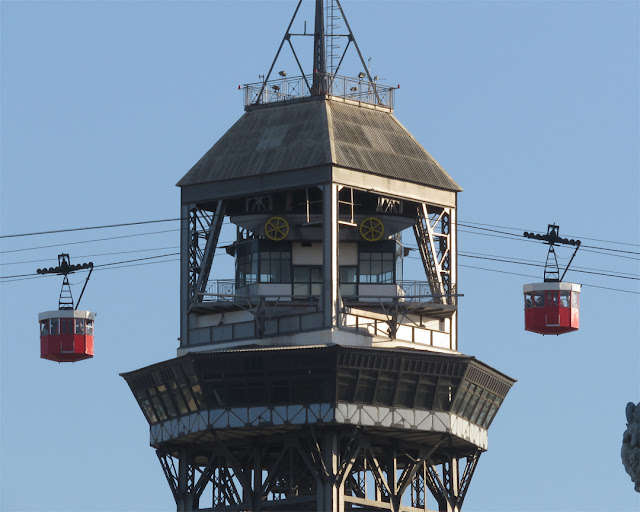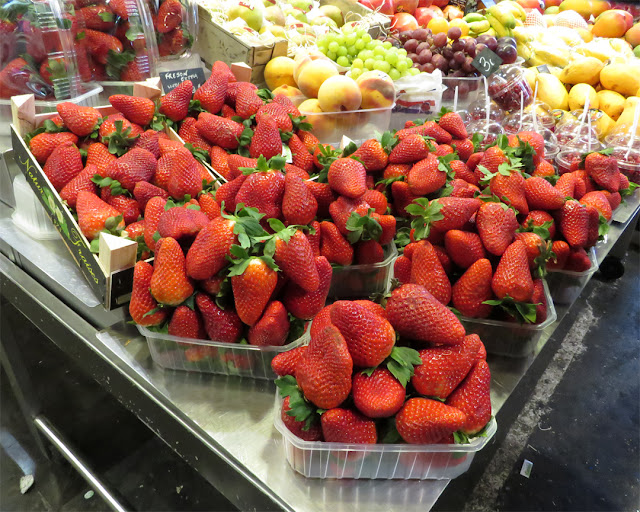Saturday, July 31, 2021
Dragon boundary mark
Dragon boundary mark
Holborn at Grays Inn Road
London, September 2014
“The dragon boundary marks are cast iron statues of dragons on metal or stone plinths that mark the boundaries of the City of London. The dragons are painted silver, with details of their wings and tongue picked out in red. The dragon stands on one rear leg, the other lifted against a shield, with the right foreleg raised and the left foreleg holding a shield which bears the City of London's coat of arms, painted in red and white. This stance is the equivalent of the rampant heraldic attitude of the supporters of the City's arms.” (Dragon boundary mark, Wikipedia)
Friday, July 30, 2021
Thursday, July 29, 2021
Swietopelk II the Great
Pomnik Świętopełka II Wielkiego (Monument of Swietopelk II the Great) by Wawrzyniec Samp
ulica Szeroka
Gdańsk, September 2018
Wednesday, July 28, 2021
Pau Claris i Casademunt
Statue of Pau Claris i Casademunt by Rafael Atché
Passeig de Lluís Companys
Barcelona, March 2017
“This bronze statue of Pau Claris was inaugurated in 1880 and originally stood on what is now Via Laietana. It was withdrawn from public display during the Spanish Civil War, as were other monuments to famous Catalan figures such as Dr Bartomeu Robert and Rafael Casanova. In 1977 the statues were restored and reinstated in new locations throughout Barcelona. Pau Claris Caseldemunt was born in Barcelona in 1586 and was the President of Catalonia at the start of the Catalan Revolt. In Catalan the revolt is called La Guerra dels Segadors which means the war of the reapers, refering to the farm workers who came to Barcelona from across Catalonia to take part in the revolution. Pau Claris died in 1641 shortly after the revolt began, allegedly poisoned by (for) Philip IV of Spain.” (Statue of Pau Claris, Barcelona Lowdown)
Tuesday, July 27, 2021
Monday, July 26, 2021
King John III Sobieski
Monument to King John III Sobieski by André Le Brun and Franciszek Pinck, 1788
Łazienki Park (Royal Baths Park)
Aleje Ujazdowskie
Warsaw, September 2018
“A bridge with a monument to King John III Sobieski closes off the view from the north windows of the Łazienki Palace. The bridge, originally single-span, covered with stone panels, was erected in 1777–80. In 1877, when the canal was widened, two new spans were added on the east side. The central section of the bridge was designed by Dominik Merlini. The King Sobieski Monument was designed by Andre Le Brun, who modelled it on King John Sobieski's equestrian statue at Wilanów. The statue's execution was made easier by a rough-hewn stone block, set aside for this purpose, that had lain at the Szydłowiec quarry since Sobieski's time. The monument shows a rider in knight's armor astride a rearing steed whose hooves trample two Ottoman Turks. The monument symbolizes Sobieski's victory over the Turks at the Battle of Vienna (1683).” (Łazienki Park, Wikipedia)
Sunday, July 25, 2021
Gardens of Staple Inn
Gardens of Staple Inn
Farringdon Without
City of London
London, September 2014
“Staple Inn is a part-Tudor building on the south side of High Holborn street in the City of London, London, England. Located near Chancery Lane tube station, it is used as the London venue for meetings of the Institute and Faculty of Actuaries, and is the last surviving Inn of Chancery. It was designated a Grade I listed building in 1974.” (Staple Inn, Wikipedia)
Saturday, July 24, 2021
Statue of Enea
Enea, Anchise e Ascanio (Aeneas, Anchises, and Ascanius) by Taddeo Carlone, 1578
Piazza Bandiera
Genoa, April 2016
Friday, July 23, 2021
Thursday, July 22, 2021
Wednesday, July 21, 2021
Tuesday, July 20, 2021
Monument to the Poles
Monument to the Poles who died for the Gdansk Polishness (1939-1945) by Wawrzyniec Samp, 1969
ulica Podwale Staromiejskie
Gdańsk, September 2018
Monday, July 19, 2021
Great Hall
Chimneys of the Great (or New) Hall
Lincoln's Inn
Holborn, Camden
London, September 2014
“The Great Hall, or New Hall, was constructed during the 19th century. The Inn's membership had grown to the point where the Old Hall was too small for meetings, and so the Benchers decided to construct a new hall, also containing sizable rooms for their use, and a library. The new building was designed by Philip Hardwick, with the foundation stone laid on 20 April 1843 by James Lewis Knight-Bruce, the Treasurer. The building was completed by 1845, and opened by Queen Victoria on 30 October. The Hall is 120 feet (37 metres) long, 45 ft (14 m) wide, and 62 ft (19 m) high, much larger than the Old Hall. The Great Hall is used for the call to the Bar, as a dining place and for concerts arranged through the Bar Musical Society.” (Lincoln's Inn, Wikipedia)
Sunday, July 18, 2021
Saturday, July 17, 2021
Temple of Diana
Temple of Diana
Łazienki Park (Royal Baths Park)
Aleje Ujazdowskie
Warsaw, September 2018
“In 1822, Jakub Kubicki erected a classicist temple to the goddess Diana. Also called the ‘Temple of the Sibyl,’ it stands next to the northwest part of the southern Łazienki lake. The wooden building is massive and decorated inside with murals with flower and fruit motifs.” (Łazienki Park, Wikipedia)
Friday, July 16, 2021
Torre Jaume I
Torre Jaume I
Telefèric del Port or Aeri del Port (Port Vell Aerial Tramway)
Port Vell (Old Harbor)
Barcelona, March 2017
“Torre Jaume I is a 107-metre (351 feet) high steel truss tower in Barcelona, Catalonia, Spain, which was built in 1931 by Carlos Boigas. The tower is currently the fifth-tallest aerial lift pylon in the world, and is a part of the Port Vell Aerial Tramway from Torre Sant Sebastia to Montjuïc. Torre Jaume I also has an observation platform.” (Torre Jaume I, Wikipedia)
Thursday, July 15, 2021
Madonna del Rosario
Colonna della Madonna del Rosario (Column of Our Lady of the Rosary), 1632
Piazza San Domenico
Bologna, June 2015
Wednesday, July 14, 2021
Pomnik Mikołaja Kopernika
Pomnik Mikołaja Kopernika (Nicolaus Copernicus Monument) by Cyprian Godebski, 1899
Collegium Witkowski
ulica Gołębia
Kraków, September 2018
“The Nicolaus Copernicus Monument in Kraków (Pomnik Mikołaja Kopernika) is a notable landmark of Kraków, Poland. It memorializes the astronomer Copernicus, who studied at the Kraków Academy and whose father came from that city, then the capital of Poland. The statue, designed by sculptor Cyprian Godebski in 1899, was completed in 1900. It originally stood in the courtyard of the Jagiellonian University's Collegium Maius. In 1953 it was moved to Kraków's Planty Park, in front of the Collegium Witkowski building.” (Nicolaus Copernicus Monument, Wikipedia)
Tuesday, July 13, 2021
Texas Legation
Commemorative plaque showing final location of Texas Legation in London from 1842-1845
St James's Street, St. James's
City of Westminster
London, September 2014
“A Texas Legation was maintained by the Republic of Texas in Washington, D.C., London, and Paris (1 Place Vendôme) from 1836 through 1845. In a bid to protect itself from almost certain invasion by forces from neighboring Mexico, the government of the republic sought to foster international ties. It did this by also opening the Texas Legations in London and Paris. Their opening is believed by some academics to be less an attempt by Texas to enter the international stage as an independent country and more a maneuver to prompt officials in the United States to worry that an independent Texas might allow British and French soldiers to mass on the southern border of the U.S. When Texas sought to join the United States in 1845, the British Empire supported keeping it independent. The British even offered to guarantee Texas's borders with both the United States and Mexico. Texas was a tactical ally of Britain acting as a counterweight to the United States. Nonetheless an independent Texas was probably inviable for financial reasons, and when the Republic became a state in 1845 the legations were shut down. The Texas Legation in London was located in Pickering Place, an alley off the east side of St. James's Street near St. James's Palace in a building that also houses Berry Bros. & Rudd, a prestigious wine merchants' firm that has been at that site since 1730. On the north side of the building is a plaque marking it as the site of the legation. At the top of the plaque is the seal of the Republic of Texas. The text of the plaque reads: ‘Texas Legation In this building was the legation for the ministers from the Republic of Texas to the Court of St. James 1842 - 1845. Erected by the Anglo-Texan Society’. The plaque was erected in 1963. Anglo-Texan Society member Alfred Bossom led the effort to erect the plaque and the honour of its unveiling went to then-Governor Price Daniel.” (Texas Legation, Wikipedia)
Monday, July 12, 2021
Giardini di Plastica
Giardini di Plastica (Plastic Gardens)
Giardini Baltimora (Baltimora Gardens)
Via del Colle
Genoa, April 2016
“Between the late 1960s and the early 1970s, the area of the centro storico known as Via Madre di Dio was razed to the ground and replaced with a modernist conglomerate of office buildings known as Centro dei Liguri. Immediately by pushers and heroin addicts, the adjacent park was dubbed ‘Giardini di Plastica’ (Plastic Gardens) and proactively avoided by everybody else.” (Introduction, Creative Urbanity)
Sunday, July 11, 2021
Zaha Hadid Haus

Spittelau Viaducts Housing Project by Zaha Hadid Architects, 1994-2006
Spittelauer Lände
Vienna, June 2018
“As part of an initiative undertaken by the City of Vienna to revitalize the Wiener Guertel, a neglected urban hinterland which traditionally marked the ‘dividing line’ between indigenous Viennese and immigrant communities, we designed and constructed the Spittelau Viaducts Housing Project. The development stands at a point where several significant infrastructural elements overlap: The ‘Spittelauer Laende’, one of Vienna’s most important roadways; the Danube Canal, connecting Germany to Hungary, a busy bike path and an unused railway viaduct constructed by Otto Wagner in the 19thcentury. We created a three-part structure, containing apartments, offices and artists’ studios, which effectively weaves like a ribbon through, around and over the arched bays of the disused railway viaduct, which is a protected structure. The new buildings interact with the viaduct in a deliberately playful manner, generating many different exterior and interior spaces and vistas – their impact heightened by the surrounding infrastructure. A number of viaduct arches were converted into bars and restaurants, others transformed to carry a service zone which ultimately melts into the banks of the canal, forming a lively public space. Spittelau Viaducts was conceived to extend Vienna’s social housing provision and as a ‘beacon’ project to attract and inspire further developments in this area. Future plans included the creation of pedestrian and bike connections to the University of Business and Northern Train Station.” (Spittelau Viaducts Housing Project, Zaha Hadid Architects)
Saturday, July 10, 2021
Strawberries
Mercat de Sant Josep de la Boqueria
La Rambla
Ciutat Vella
Barcelona, March 2017
“The Mercat de Sant Josep de la Boqueria, often simply referred to as La Boqueria (La Boquería), is a large public market in the Ciutat Vella district of Barcelona, Catalonia, Spain, and one of the city's foremost tourist landmarks, with an entrance from La Rambla, not far from the Liceu, Barcelona's opera house. The market has a very diverse selection of goods.” (La Boqueria, Wikipedia)
Friday, July 9, 2021
Thursday, July 8, 2021
Wednesday, July 7, 2021
St James's Palace
St James's Palace
Marlborough Road, St. James's
City of Weatminster
London, September 2014
“St James's Palace is the most senior royal palace in the United Kingdom. It gives its name to the Court of St James's, which is the monarch's royal court and is located in the City of Westminster in London. Although no longer the principal residence of the monarch, it is the ceremonial meeting place of the Accession Council, the office of the Marshal of the Diplomatic Corps, and the London residence of several minor members of the royal family. Built by order of Henry VIII in the 1530s on the site of a leper hospital dedicated to Saint James the Less, the palace was secondary in importance to the Palace of Whitehall for most Tudor and Stuart monarchs. The palace increased in importance during the reigns of the early Georgian monarchy, but was displaced by Buckingham Palace in the late 18th and early 19th centuries. After decades of being used increasingly for only formal occasions, the move was formalised by Queen Victoria in 1837. Today the palace houses a number of official offices, societies and collections, and all ambassadors and high commissioners to the United Kingdom are still accredited to the Court of St James's. The palace's Chapel Royal is still used for functions of the British royal family. Mainly built between 1531 and 1536 in red-brick, the palace's architecture is primarily Tudor in style. A fire in 1809 destroyed parts of the structure, including the monarch's private apartments, which were never replaced. Some 17th-century interiors survive, but most were remodelled in the 19th century.” (St James's Palace, Wikipedia)
Tuesday, July 6, 2021
Monday, July 5, 2021
Pałac Na Wyspie
Pałac Na Wyspie (Palace on the Isle)
Łazienki Park (Royal Baths Park)
Aleje Ujazdowskie
Warsaw, September 2018
“The Palace on the Isle (Polish: Pałac Na Wyspie), also known as Baths Palace (Polish: Pałac Łazienkowski), is a classicist palace in Warsaw's Royal Baths Park, the city's largest park, occupying over 76 hectares of the city center. From 1674 the property and the nearby Ujazdów Castle belonged to Count Stanisław Herakliusz Lubomirski, who commissioned a Baroque bath house called "Łazienka", similarly to a number of other European historic sites, including England's city of Bath. The building, erected on a square plan, was richly decorated with stuccos, statues, and paintings; some of the original decorations and architectural details survive. In 1766 King Stanislaus Augustus purchased the estate and converted the bathing pavilion into a classicist summer residence, with an English garden. During the final stages of World War II, the retreating Germans devastated the interior of the Palace and drilled holes in the structure in preparation for destruction. However, the plan was never carried out.” (Palace on the Isle, Wikipedia)
Sunday, July 4, 2021
Rocambolesc
Rocambolesc Gelateria
La Rambla
Ciutat Vella
Barcelona, March 2017
“Before I tell you about Rocambolesc, first you should know about the origins of its owners, Jordi Roca, the World's Best Pastry Chef in 2014 and desserts chef at one of the best restaurants El Celler de Can Roca, located in Girona (a city just one hour away from Barcelona). Knowing this, your expectations will be quite high, and I am sure you will not be disappointed! From the first moment you pass by and notice the ‘gelateria’ which could have been taken from the movie Charlie and the Chocolate Factory, this ice-cream store is a real experience.” (Rocambolesc, Spotted by Locals)
Saturday, July 3, 2021
Il Resto del Carlino
“Il Resto del Carlino”
Palazzo Pallotti
Via Garibaldi
Bologna, June 2015
“Il Resto del Carlino is an Italian newspaper based in Bologna, and is one of the oldest newspapers in Italy. Its rather evocative name means "the change you get from a carlino", which the smallest part of the Papal baiocco (no longer legal tender in united Italy but a word still used in Bologna to refer to 10 cent coins): a sheet of local news was given out in shops to make up for any change owing after buying a cigar (which was worth 10 cents).” (Il Resto del Carlino, Wikipedia)
Friday, July 2, 2021
Thursday, July 1, 2021
Millbank Tower
Millbank Tower
Millbank
City of Westminster
London, September 2014
“Millbank Tower is a 119-metre (390 ft) high skyscraper in the City of Westminster at Millbank, by the River Thames in London. The tower was constructed in 1963, and has been home to many high-profile political organisations, including the Labour and Conservative parties, and the United Nations. The tower was constructed in 1963 for Vickers and was therefore originally known as Vickers House or the Vickers Tower. It was designed by Ronald Ward and Partners and built by John Mowlem & Co. It is a landmark on the London skyline, standing beside the River Thames, half a mile upstream from the Palace of Westminster. The tower has been owned by David and Simon Reuben since 2002, while still being managed by its former owner Tishman Speyer Properties. It is a Grade II listed building. Until the BT Tower's completion in 1964, Millbank Tower was the tallest building in the United Kingdom. The 2003 edition of the Pevsner architectural guide says that the Millbank Tower is ‘one of the few London office towers to have won affection’, and contrasts it with the ‘boxy structure’ of the Shell Tower at Waterloo.” (Millbank Tower, Wikipedia)
Subscribe to:
Posts (Atom)






























